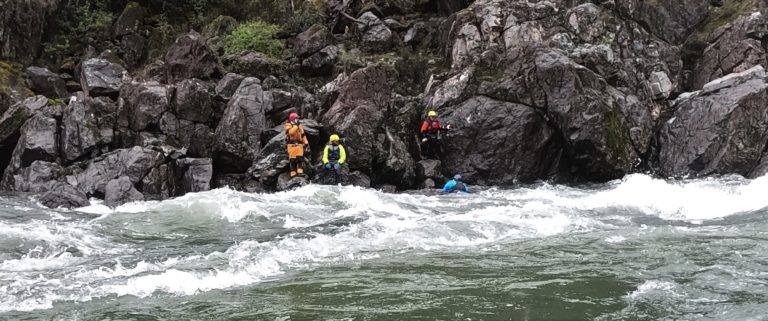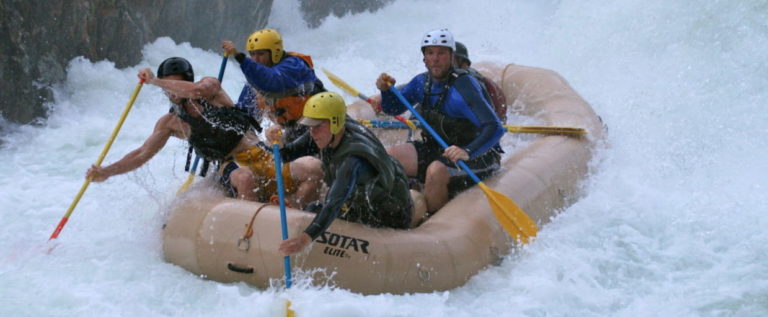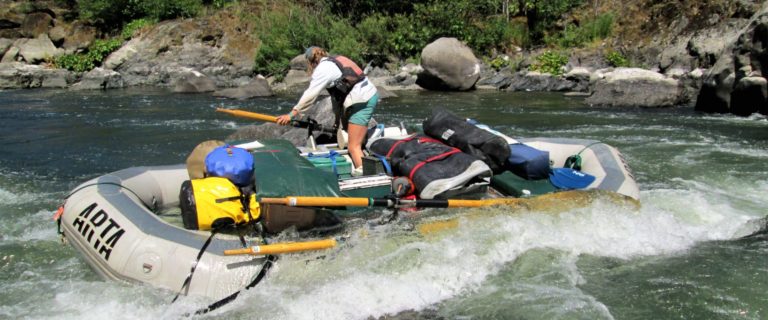Numerous people stop rafting rivers after a bad swim. Most bad swims can be prevented by training of crews to keep everyone in the raft, wearing more flotation and using best practices once in a rapid. A key component is training with whitewater skills regularly to be comfortable using the swimming techniques and one’s PPE (personal protective equipment).
Active Swimming: Self-rescue
This is the preferred technique and should be used during most whitewater swims. Be an active part of your rescue rather than lying on your back waiting for someone to come rescue you. The most common use of active swimming is to swim back to the raft you just exited.
Active Swimming Technique
- Eye-on-the-prize: look where you want to swim. Always swim head up. If your head is down you’ll loose your angle and swimming in the right direction is the first priority.
- Kick your feet: Kicking your feet gives you power. Your feet also stay at the surface so they create less drag. The current along the surface is also slower so less force is being applied to your body by the river than if it were deeper in the water.
- Throw your hands at your destination: freestyle arm strokes work best. When swimming head-up freestyle, your arms are only in the water when they are pulling you in the direction you want to go.
Video: Active Whitewater Swimming to Shore
Where to Swim in a Rapid – River Exits
The quicker you can get out of the river the better. The best exit from a rapid is the closest one. Common exits from the river include: your raft, another raft, shore, an eddy, a rock in the middle of the river. Swim on your stomach when people are pointing you in a direction using hand signals or to avoid a strainer.
Swimming Back to Your Raft
During most whitewater swims people fall out of the raft and come up next to the raft or a little downstream of the raft. If you find yourself next to the raft grab on to it. The longer you float in a rapid the more likely you will be separated from the raft.
If you find yourself out of reach of the raft and you’ve held onto your paddle it is easy to extent the paddle “T” (handle) to someone in the raft who can pull you back to the raft by the paddle. A paddler in the raft can also extend their paddle “T” to a swimming in the river. If the swimmer is a little out of reach for a paddle they will need swim a couple strokes to get close enough to use a paddle extension (we’ll talk about swimming whitewater with a paddle later).
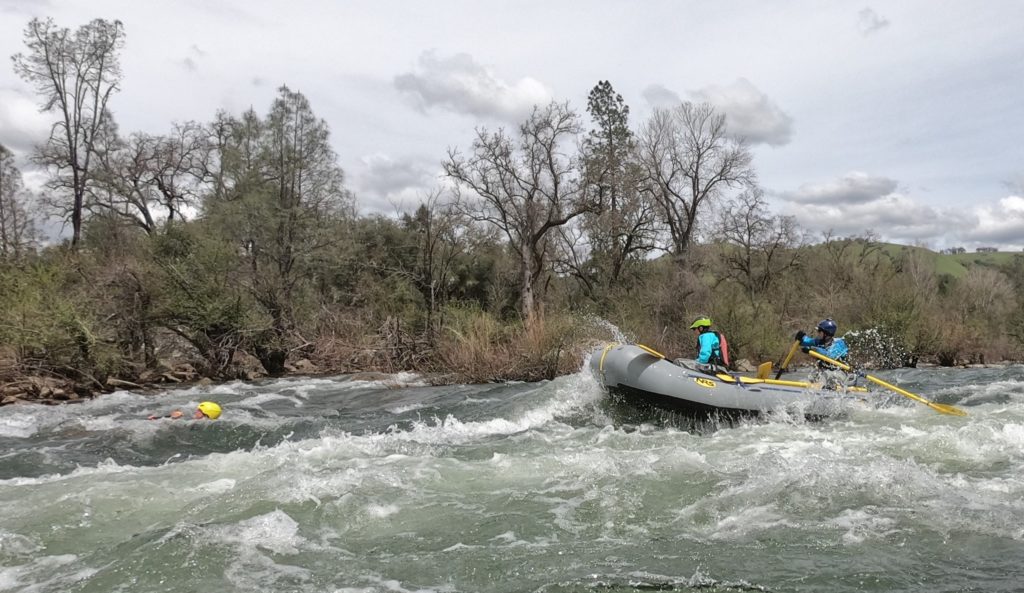
Swimming to Another Raft
Many times a raft will stop or be slowed in a hole or on a rock and have people fall out in the process. Typically once swimmers are a little farther away from their own raft and closer to a downstream raft it is easier to swim to the downstream raft. Swimmers often catch more current than rafts and move faster downstream than a raft making it difficult for a raft to catch up to downstream swimmer or for downstream swimmers to swim back upstream to a raft. Active swimming on the stomach using head up freestyle is the fastest way to get to the downstream raft. Once within a paddle length all the tricks discussed above can be used.
While it is important for guides to look upstream to make sure there are not swimmers behind them, this does not always happen. Swimmers in the water help their cause by calling out to the raft in front of them if it appears the raft doesn’t realize they are behind them.
Do no stand up in fast moving current, instead swim/crawl out of the river. A basic rule is don’t stand up in fast moving current above your knee.
Swimming to Shore
On high volume rivers the quickest exit from the river is swimming to a raft. On low volume rivers many times it is best to swim to shore. If there is not a strong eddy fence it works best to swim perpendicular to the current straight towards shore. Keep swimming on your stomach until you can’t swim any longer than crawl out of the river on all fours (using hands and feet). Get yourself out of the river as it is usually cold and taking energy away from you. Make sure you are someplace you can be seen. Be careful climbing out of the river. More people get hurt in the zone between river and shore than anywhere else on a river.
Foot Entrapment
When swimming toward shore many people have the desire to stand up and walk along the river since we are better walkers than swimmers. However, walking in the river where there is fast current is dangerous. One’s foot can get caught under a rock or log on the bottom of the river. Then the power of the river will force the person’s head under water. It is extremely challenging to extract someone from this position but it is easy to prevent. Do no stand up in fast moving current, instead swim/crawl out of the river. A basic rule is don’t stand up in fast moving current above your knee.
Entrapment Video – Keep those feet up!
Swimming to an Eddy
Eddies are places of refuge typically found behind rocks or on the inside bend of a river. The challenge is getting into the eddy. The transition from downstream current to the eddy is called an eddy fence and it can be difficult to cross the fence.
How to catch an eddy
Swimming to catch an eddy is the same as catching an eddy in a raft. A downstream angle with momentum works best. Approach the eddy swimming head first downstream. Make sure to kick hard and swim aggressively the last couple of strokes before hitting the eddy fence. You’ll most likely loose your angle a bit when you hit the eddy fence, be sure to keep swimming towards shore at this point. In general being perpendicular to the current works best. Keep your body on the surface to have more control.
If you find yourself parallel to the eddy fence some people have had success spinning into the eddy going from back to front to back to front rolling your way into the eddy and grabbing water with each arm/hand in succession.
Swim onto a rock
On rocky low volume rivers there are occasionally flatter rocks in slower current that you can swim to from the upstream side and get out of the river. While this gets you out of the river it does leave you stranded in the middle of the river and you will need someone to come with a raft or toss you a throw bag from shore.
Rapids with Big waves
While it is common practice to float feet first through large clean (no rocks) wave trains like Hermit Rapid on the Grand Canyon, it is more controlled to swim head first. Think about playing in the ocean and a set of waves comes towards you, it works way better to swim towards them head first then duck under the wave and breathe in the trough off the wave before the next one comes. The same is true on a river.
Floating Toward a Strainer
A strainer is anything the river flows through that people will not flow through. Examples include branches dangling down in the river, a log across the river just at the surface, the river flowing through bushes or a pile of rocks. In all these cases a swimmer would want to avoid floating into the strainer if possible. The best way to avoid a strainer is to let go of your paddle (if still holding), get on your stomach and swim perpendicular to the current toward the middle of the river or shore. Most strainers are near shore so the middle of the river is usually safer. Having said that, if you can get to shore before the strainer that is best. You’ve avoided the strainer and gotten yourself out of the river.
If you can’t avoid the strainer than you would want to swim on you stomach head first towards the strainer using your hands to help keep you on top of the strainer.
Passive/Defensive Whitewater Swimming
- On back with feet pointed downstream with toes out of the water.
- backstroke with both arms simultaneously to ferry toward the right or left shore.
- Use your feet to fend off rocks
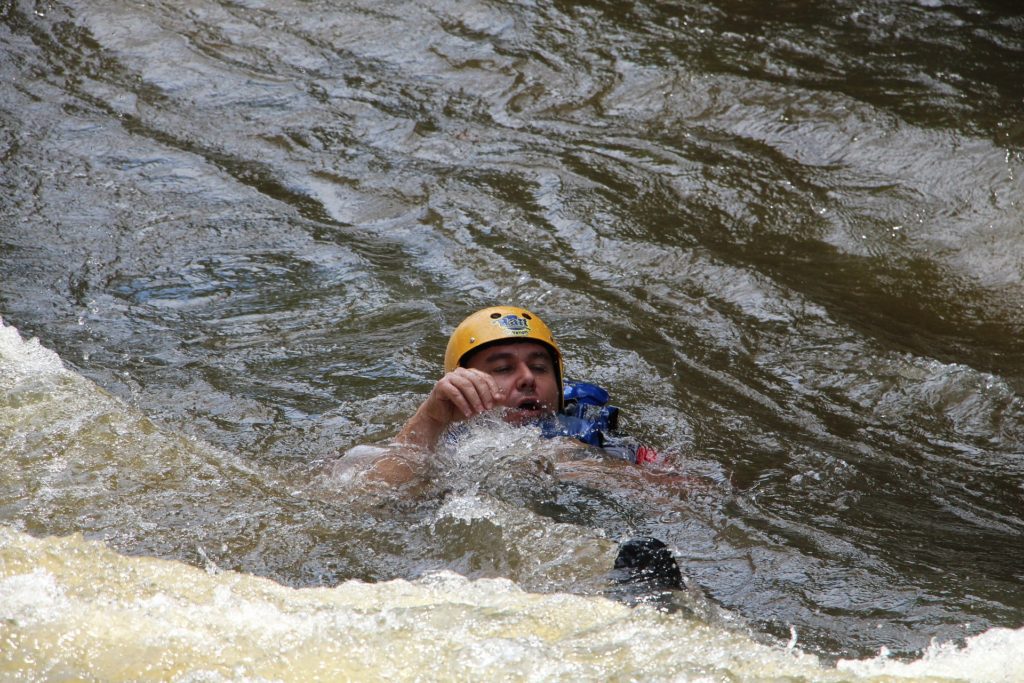
When to Swim Whitewater in a Passive Position
- You see a horizon line in front of you, that means a line across the river with nothing behind it. That indicates a drop is coming and you want to get your feet pointed downstream. Try to keep your feet the surface as you go over the drop to avoid a foot entrapment.
- When you float toward a rock or other object use your feet to push yourself around.
- It is so chaotic you don’t know what to do. Put your feet downstream until you can get your bearings. Then roll to your stomach and swim to get yourself out of the river.
Getting out from under the raft
If you find yourself underneath a raft, put your nose to the bottom of the raft so you are on your back. Let go of your paddle and push yourself head first down and out from underneath the raft while kicking your feet. Don’t change directions, just keep going in the same direction. The same is true for an upside down raft except take a big breath before getting out from underneath the raft.
Once out from underneath the raft grab onto the side of the raft since getting back into the raft will be your quickest exit from the river. Be careful about being on the downstream side of the raft as you can get crunched between the raft and a rock. Also, remember to keep your feet up. Many people drop their feet when they start holding onto a raft.
Swimming Holes
There are three exits from most holes: out the bottom, the left side and right side of the hole. If you find yourself going underwater and coming up, then going under and coming up again and think that the rocks or tree you are seeing look familiar or that you aren’t going downstream. You might be stuck in a hole.
Try rolling up into a ball. Many people find success rolling up into a ball and getting pushed out the bottom of the hole. It also can help to relax and just let your body go with the current. Many times I’ve seen people fighting trying to swim away from the hole to finally give up and then the hole takes them down and spits them out.
To get out the sides of the hole swim towards the left or right side. You may go under and pop up a couple of times. Keep swimming between these events until you can get your body in the downstream current on either side of the hole.
To hold or not hold onto a paddle
A paddle is a $20 to $30 piece of equipment. It is good to hold onto the paddle when falling out so you can use it as an extension to get back in the raft and once back in the raft you can paddle rather than sit there while your paddling-mates chase down your paddle. If you need to swim hard to get out of the river or avoid a hazard let go of your paddle. However, if the float is pretty mellow and you don’t need to swim that aggressively it is best to hold on it. In some places paddles are hard to come by and it is much more important to hold onto it.
Swimming with a Paddle
When on your back to go over a drop hold the shaft of the paddle such that the paddle “T” is above your head and the blade is near your torso. This will keep the paddle from whipping around.
When swimming on your stomach hold the paddle “T” in one hand. Wrap 4 fingers over the top of the handle and tuck your thumb underneath allowing the blade to drag behind you. Sometimes it works best to throw the paddle ahead of you into an eddy and then swim in after it.
Whitewater Swim Practice/Training
Many guides will take a swiftwater rescue class every few years. This is an excellent way to get practice swimming in the river. However, it is better to practice in the river more regularly. Maintain skills by practicing swimming wave trains, holes, catching eddies, as well as climbing back into rafts and flipping rafts. Be sure to practice swimming and self-rescue skills while holding a paddle as well.
New gear
Whenever you get new gear it is best to do some practice swims before using the gear on a challenging stretch of river where self-rescue is imperative. Testing insures helmet fit properly so they stay in place when swimming. New Pfd’s can shift making it challenging to swim. Know your gear and practice with it.
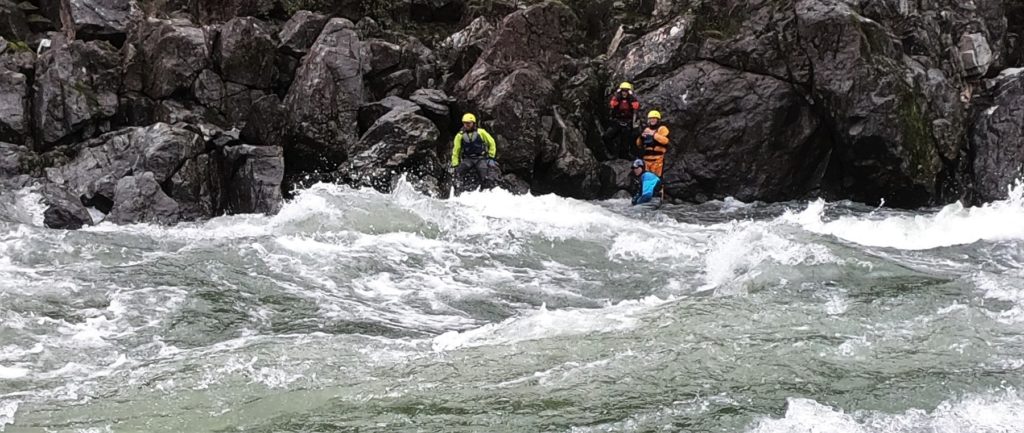
Selecting PPE
Having the right gear can make a huge difference in your swimming experience. Use a high flotation PFD, have a solid helmet that fits well, make sure you have minimal drag and proper protection from cold water. I prefer PFDs with at least 22 lbs of flotation. Helmets depend upon the shape of your head but in general more coverage is better. Hats under helmets can work well but at other times will fall down in front of a swimmer’s face. Minimize drag by not attaching gear to you lifejacket, selecting light weight shoes, and avoid wearing shorts over your wetsuit. Learn more setting yourself up for success with our article on PFD flotation.
Fitness/Swimming Skills
While some rafting companies will take people who do not know how to swim, being a fit, good swimmer is one of the best ways to avoid a bad white water swim. Also lighter people tend to spend less time underwater. As with any physical activity fitness is important. The class IV and V guides I’ve worked with trained in the off season to be in shape to run the river and swim in the river.
Concluding Thoughts on Swimming Whitewater Rapids
Knowing and routinely practicing whitewater swimming is key to minimizing the likelihood of a bad swim. While taking a swiftwater course is ideal for training, it is easy to hop in a rapid on your next trip and practice some basic techniques in a low risk environment. In general it is better to swim aggressively on your stomach rather than waiting for someone to come rescue you. Finally be sure to dress for success, cold water makes it more challenging to breath and move when not properly insulated with a wetsuit or drysuit. Be sure your using proper techniques with a drysuit to avoid blowing a gasket and getting pinhole leaks.
